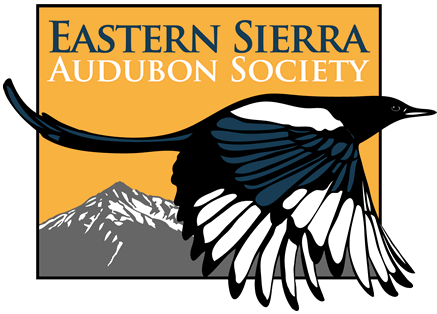[Originally appeared in the Sierra Wave newsletter, Vol. 26, No. 2, Nov-Dec 2007 – click here for original with photos]
This small, charistmatic, gray desert bird is North Americas only representative of the Remizidae, a family of tits found throughout the world. The yellow head, chestnut shoulder patch and distinctive three-note vocalization makes this an obvious species of the drier deserts from Texas to southeastern California. Both sexes build volleyball-sized and shaped nests in mesquite trees and other thorny trees and shrubs, some used for roosting and others for nesting. These nests are often the first indication that you are in Verdin territory.
The Death Valley Expedition of 1891 recorded the first Verdins for Inyo County when Mr. Frank Stephens collected a male at Resting Springs 13 February 1891. This small location is a few miles north of the San Bernardino line and a few miles west of the Nevada line.
In 1917, the Museum of Vertebrate Zoology at Berkeley began a project to document the vertebrates of Inyo County. Tracy I. Storer, a respected zoologist, spent part of February collecting data at Shoshone, just 15 miles northwest of Resting Springs. He found no Verdins and no nests, indicating that they had not moved beyond the original site. In April and May, Dr. Joseph Grinnell, the dean of California ornithology, surveyed birds at Furnace Creek Ranch. He found no nests and heard no vocalizations during a time when they are extremely vocal while setting up their breeding territories.

Verdin, Photo by Jo Heindel
No further work was done there until October 1933 when Grinnell returned to continue his studies and found that during the interim Verdins had colonized Furnace Creek Ranch. M. French Gilman, a maintenance supervisor and knowledgeable birder at the ranch, told Grinnell that there were Verdin nests at Shoshone as well.
The species continued at Furnace Creek Ranch and was reported again in 1961 and through the 1970s and 1980s. During this time reports came from Mesquite Springs and Scottys Castle, north of the ranch, and breeding is regularly documented there to the present time. They moved west to Emigrant Ranger Station, Darwin Falls, Haiwee Reservoir, Little Lake and a few canyons on the southeast slope of the Sierra Nevada (e.g. Nine-mile and Sand Canyons).
Other species have forged into new breeding areas only to withdraw after a few decades or longer. It remains to be seen if this species can endure in the newly colonized areas, and what motivated this range expansion awaits answers from a future scholar.
Tags: owl
